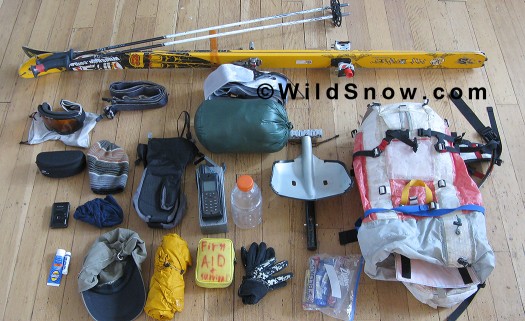Nearly every spring, I have fun redeveloping my super-lightweight backcountry skiing corn harvesting kit. This year’s iteration in ultra low mass mode:
I’m considering this the “non skin-out” weight, more what my pack would weigh if I was booting on a warmer morning. Sort of from top, and left to right: My trusty carbon fiber poles, cobbled from some Solly alpine poles, 15 ounce for the pair. K2 Wayback 167 cm, legacy model, one ounce lighter per ski than current model and no rocker, sometimes I like ’em better, sometimes not, 125.4 ounces (pair) with Dynafit Titanium toe and TLT heel, no brakes.
Generic goggles in soft case, 3.9 ounces. Regular skins, nylon, 16.8 ounces pair. Puff jacket in green stuffsack, 14.3 ounces, also carry a light fleece pullover that is usually worn so not included in pack weight. Cilogear 30 liter Worksack backpack, 38 ounces, a bit heavy but will never tear or otherwise self destruct as super lightweight packs may do when pressed into service for rock scrambles or bushwhacking.
Sunglasses in black case, I’m still using the Smith Trace at 3.8 ounces with two sets of lenses, one dark and one amber. Below sunglasses case is Canon Powershot SD780, not my favorite camera but it does have an optical viewfinder, shoots HD vid and only weighs 4.6 ounces (no manual mode, groan). Medium weight fleece ski cap, 2.3 ounces. Forlorne looking item below ski cap is polypro balaclava, I never go anywhere without it, 1 ounce. Overmitt shells (mostly for emergency use), 6 ounces. Satphone Iridium in case, 12.7 ounces. Proverbial plastic drink bottle, 1.7 ounces. Arva titanium carbon-shaft shovel, one use only, 13 ounces.
Can’t forget the headlamp, as spring starts around here = early starts in the dark. But no need for anything huge, e.g., any of the smaller BD headlamps work well. My current one weighs 3.1 ounces.
Sunscreen/chapstick, 1.3 ounces. Sun hat,, 3.1 ounces (modified with chin string and outside band cut off). Rain shell, OR Helium, highly recommended for a low mass shell at 7.9 ounces. Repair & first aid kit for backcountry skiing, 14.7 ounces (includes multi-too, compass, etc.). OR Omni gloves, 2.6 ounces.
Water, minimum is about 32 ounces for me, double that for a bigger day. I left it out of the overall calculation because the exact amount is optional. More, on spring trips I’ll sometimes carry a smaller amount and add melt-snow during the march.
Food, I go light. Some gels, a bit of chocolate. For a bigger day 8 ounces of that stuff seems to do it for me, or a few extra gels just to be safe. But let’s say 8 ounces.
Optional backcountry skiing gear not in photo: B&D ski crampons with biner, 9.8 ounces. Black Diamond Tracer Helmet, 9 ounces. FRS radio Motorola (uses AA batteries, a bit large but very nice, abuse tested on Denali), 5.2 ounces with lithium batteries. Homebrew skinny skins for long flattish approaches, 6.4 ounces pair (carried along with regular skins if deemed necessary).
Listed:
Carbon poles, non adjustable: 15 oz.
Skis: 125.4 oz.
Goggles: 3.9 oz.
Skins, regular width: 16.8 oz
Puff jacket, down: 14.4 oz.
Rucksack for backcountry skiing: 38 oz.
Sunglasses: 3.8 oz.
Camera: 4.6 oz.
Ski cap: 2.3 oz.
Balaclava: 1 oz.
Overmitts: 6 oz.
Headlamp: 3.1 oz.
Satphone: 12.7 oz.
Water bottle (no water): 1.7 oz.
Food: 8 oz.
Shovel: 13 oz.
Sunscreen: 1.3 oz
Sun hat: 3.1 oz
Rain shell: 7.9 oz
Repair/First-aid: 14.7 oz
Total 238.4 ounces, 14.9 lbs, 6.75852631 kilograms — quite nice for a backcountry skiing load including skis and poles!
Shop for K2 backcountry skis here.
WildSnow.com publisher emeritus and founder Lou (Louis Dawson) has a 50+ years career in climbing, backcountry skiing and ski mountaineering. He was the first person in history to ski down all 54 Colorado 14,000-foot peaks, has authored numerous books about about backcountry skiing, and has skied from the summit of Denali in Alaska, North America’s highest mountain.

